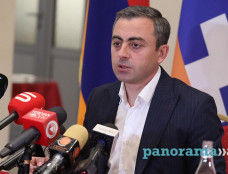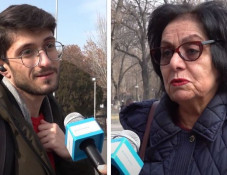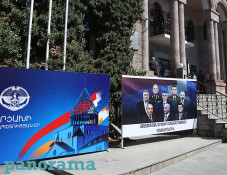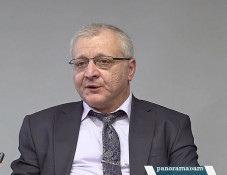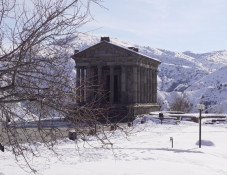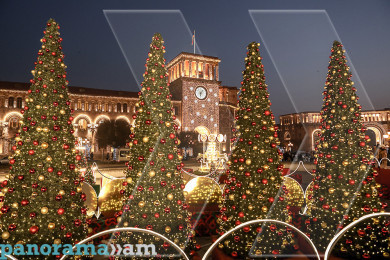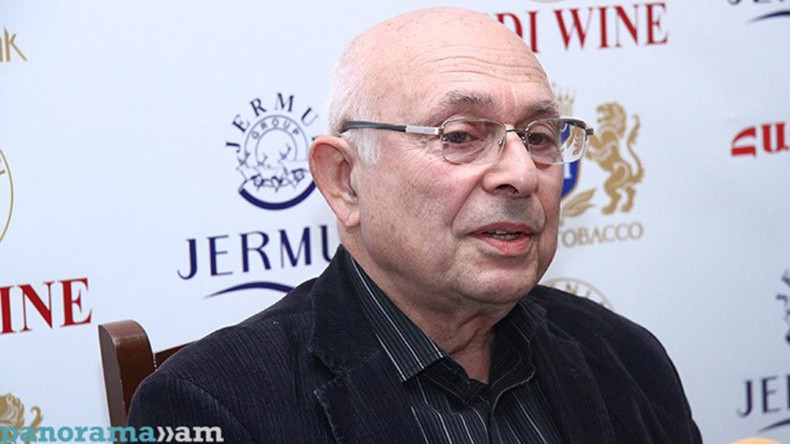
Rouben Galichian notes peculiarities of medieval Christian and Islamic Cartography and Azerbaijan’s absence on maps
Bishop Isidore of Seville (560-636) was a highly influential medieval cleric who composed a compendium of world knowledge and philosophy, thus becoming the last classic philosopher of the western Christianity and one of the most reputable people in Europe, writes famous cartographer Rouben Galichian in his book Historical and Geographical Falsifications of Azerbaijan, a historical, cultural and cartographical research based on a detailed analysis backed by documentary evidence.
St. Isidore’s compendium is titled Etymology and consists of twenty books, the thirteenth of which is titled ‘The World and Its Parts.’ “The material and information provided in the book are taken mainly from the writings of Salinus (3rd century BC), Pliny the Elder (23-79) and others,” Galichian writes and adds that Etymology contains a world map, which varies in form across the extant manuscript copies. The maps on the older copies are plain and contain a minimum of information, while those drawn later are more elaborate and reveal a mixture of different schools of cartography.
Galichian presents two reproductions of different periods of Isidore’s maps in the Appendix of the Historical and Geographical Falsifications of Azerbaijan. In the beginning, the T-O format maps of the world (a type of medieval map showing the inhabited world in a wheel’s form), drawn under religious influence, were simple and showed only the disc of the Earth and the continents. When the names of various cities and countries came to be marked on the maps, Armenia with Noah’s Ark, as well as the Caucasus Mountains, the river Araks started to appear one after another on the western Asia, with the Caucasian Albania-Aghvank being situated to the north of Araks and Media Atrpatakan to the south, Galichian writes.
He also notes another map by Isidore, known as the Mejean Map and compiled in France in the 12th century. It includes additional information and mainly names of countries. Apart from the main division of continents, the following countries are shown in the territory of Asia and Europe among other countries: Armenia, neighbouring Mesopotamia; Media, also next to Mesopotamia, Albania, located north of Armenia; Iberia, west of Albania; another Armenia (Armenia Minor), next to the region of Kilikia. “The map confirms the existence of two Armenias, Greater and Lesser, as well as Albania and Media being separate countries, with Albania placed north of them,” Galichian notes.
The third T-O format ‘World Map’ by Isodore contains even more information, namely, toponyms denoting the countries situated south of the Caucasus Mountains and Armenia. On the map, Upper Albania is north of the Caucasian Range and a hipped roof house described as Archa Noe (Noah’s Ark) is drawn on two peaks (Ararat) near it. The legend below Ararat reads ‘Montes Armenie’ (Armenian mountains), which are situated near the river Yuksis (probably, Halys or Kizilirmak), originating from Taurus (Mons Taurus) and flowing into the Black Sea.
Armenia Superior (Greater Armenia) is shown west of the gulf-like greenish Caspian Sea, which is connected to the ocean. The Caucasus Mountains (Mons Caucasus) are to the north-west of Greater Armenia. Porte Caspie (Caspian Gates) are drawn at the southern end of the mountains. “The map distinctly shows the relative positions of Armenia and Aghvank, with the former being to the south of the latter,” Galichian highlights.
He next references Beatus of Liebana (c. 730-798), a Spanish Benedictine monk and theologian. Serving in a monastery in the mountains in Spain, he produced his most famous work Commentaria in Apocalypsin, which includes a world map. The map from a manuscript copy of the Commentaria, dating to 1050 CE, is found in the Bibliotheque Nationale de France, and is known as the San Severe Copy. It contains a huge amount of geographical and historical information. “Though the map was copied from the original in 776, the copier put his taste and knowledge in it, giving the map a unique encyclopaedic character,” Galichian writes.
He presents also a map of the territory of the Caucasus with copy drawn by Konrad Miller. It shows the Caspian Sea as a gulf connected to the north-eastern ocean. The Middle East and Caucasus region are more clearly shown on the version copied by Miller. Galichian cites the topographic descriptions of Armenia and Aghvank on the map.
Armenia is situated between the Taurus and Caucasus mountains, extending to the Caspian. The River Tigris originates in the sides of Taurus. Armenia is in two parts: Upper and Lower.
Aghvank has the Caspian Sea at its east, which rises and joins with the ocean surrounding it, and extends to the Azov Marshes.
Next, Galichian refers to another copy of Beatus’ map from a manuscript kept in the Spanish city of El Burgo de Osma and dating to 1203. This is a very decorative T-O map, where the most striking feature is the Mediterranean Sea. The map abounds in miniatures of cities and countries. On it, Armenia is located on both banks of the River Kura; Aluania (Aghvank) appears west of the Caspian, and is placed north of the River Kura to the east of Armenia. Parthia and Assiria (Assyria) are located in the basin of Euphrates and Tigris south of the Taurus Mountains. Albania is noted east of Armenia, while the map has no mention of the name ‘Azerbaijan.’
The Venerable Bede (c. 672-735) is an English historian and high priest, whose most important writing, De Natura Rerum (On the Nature of Things), contains a T-O type map of the world. Bede’s maps are based on the cartographic information and maps that reached him from his predecessors. “Here, in the list of the countries in Asia, Persia and Media (future Atrpatakan) are mentioned first, and Aghvank (Albania) and Armenia are six lines below. The name ‘Azerbaijan’ is not to be found here, either, while Aghvank and Media are shown as two separate countries,” he writes.
Galichian also presents information from the Anglo-Saxon Cottonian map named after Sir Robert Cotton, one of the three people, whose collections were to become the base of the foundation of the British Museum in 1753. This small-volume map drawn in England was included in a manuscript book of 1050, which also contained calendars, tables of various types, descriptions of historic events and even a miniature world map by Macrobius with east at the top. “The Cottonian Map, as said before, was compiled in England and has direct links with the map prepared by Marcus Vespanius Agrippa during the first century CE by the order of Julius Caesar,” Galichian writes.
“Here mountains are shown green. Red is used for the Persian Gulf and the Red Sea, as well as several prominent rivers. At the top left, behind the lion, we see the Taurus Mountains, where the Tigris and Euphrates have their sources. Below this range is the legend ‘Montes Armenie’ with the three-storied ‘Arca Noe’ (Noah’s Ark) perched on top. Below Ararat, the legend ‘Armenia’ can be seen, although somewhat masked by the print-through. In the west, to the right of the Black Sea, another mountain range, again named ‘Taurus,’ can be seen. It is the second part of the lower range extending with fragments. Iberia, Georgia and Mesopotamia are the countries neighbouring Armenia. The gulf with two islands on the left of the ark is the Caspian Sea, and the locked territory of the warlike tribes Gog and Magog is below it, by the Northern Ocean,” Galichian describes.
There are two legends in the area between the Black and Caspian Seas. One reads ‘Mons Albanorum’ (Aghvank Mountains, possibly the Caucasus or Caspian Mountains) and the other is ‘regio Colchorum,’ the region of Colchis, located northeast of the Black Sea. Georgia (referred to as Hiberia) is shown south of Armenia between the two rivers rising from the Armenian plateau and Taurus, in the territory of Mesopotamia. Persia and Media are shown further south, by the Persian Gulf painted in red. There is no ‘Azerbaijan’ or ‘Atrpatakan’ mentioned on this map.
The next map presented in the book, that of Henry, Archbishop of Mainz, is known as the Sawley World Map and dates to 1180. It is taken from Henry of Mainz’s Imago Mundi (The Image of the World). “A classical T-O map, it contains additional information of Christian content. It is oriented with the east at the top, where the Terrestrial Paradise is said to be situated with its four rivers flowing to the ocean. The areas on the right bottom corner of the map are denoted as Hircania, Amazoni and Armenia. The Taurus Mountains, shown in red, are situated to the south of Armenia and extend almost to the Eastern Ocean. The tribes Gog and Magog are again fenced from the humanity with a defensive wall, but are situated east of the Caspian. Colchis is shown on the southeast of the Black Sea, by the range ‘Caspian Gates.’ Aghvank is moved to the north of the Black Sea. So, Armenia and Aghvank are shown as separate countries on the map, while the name of Azerbaijan is not present on this map either,” Galichian writes.
He next refers to a map by Grigory Bar-Ebroyo, a prominent Assyrian poet, historian, doctor and scholar, who was also known under the name Abul-Faraj. He was born in Malatya (Armenia) in 1226 and died in Maragha (Iranian province of Atrapatakan) in 1286. The map presented in Galichian’s book is copied from his book Menaret Qudhshe (Lamp of the Sanctuary). “The book reached us in three examples. Two of them are in Paris and one in Berlin. The map presented in the current book is the exact copy of that kept in Cambridge University Library, in Bar-Ali’s dictionary of the 15th century. This map is a semicircle of 210mm diameter and, as per Islamic cartography, is oriented with south at the top. It shows the northern half of the eastern hemisphere. In many traits, particularly in the division into climate zones, it resembles the maps prepared by his contemporary Persian geographer Al-Qazvini. Here, they are marked with parallel red lines, while the borders between the land and sea are drawn with thicker lines, leaving a big part of the map below the toponyms without geographic explanations,” Galichian writes.
The map particularly shows Greater Armenia and Lesser Armenia; Khlat, the capital city of Greater Armenia; Maiferkat or Mianfarkin-Tigranakert, the pre-Christian capital of Armenia; and the Lake Van. In between Van, Caucasus and the Alans, west of the Caspian Sea are the Iron Gates, that is, the Caspian or Derbent Gates. The map also shows Atrpatakan and Shirwan geographically located in the place of Aghvank.
“This Assyrian map, too, proves that Atrpatakan was an Iranian province situated to the south of the River Araks, and that there existed no country with the same name to the north of Araks,” Galichian highlights.
To be continued.
Born in Tabriz, Rouben Galichian is a descendant of refugees from Van who survived the Genocide. He received scholarship and studied engineering at Aston University, Birmingham (UK). Since in 1981, he started to study the rich cartographical heritage in the libraries of the UK and other European countries. His first research, Historic Maps of Armenia (in English), was published in 2004. It was a collection of maps from various libraries and museums in the world, where Armenia was noted, beginning from the 6th century to the present times. His second book, Armenia in World Cartography, was published in Yerevan in 2005. The research ‘Countries South of the Caucasus in Medieval Maps. Armenia, Georgia and Azerbaijan’ (in English and Armenian) was published in 2007. The book The Invention of History (in English) was published in 2009.
In his book Historical and Geographical Falsifications of Azerbaijan, published in 2013, the author details the reasons, aims and methodology of the falsification of the history of Azerbaijan and the countries of the region.
Related news
- Rouben Galichian: Armenia and South Caucasus in early medieval cartographers’ works
- Rouben Galichian: Name Hayastan, Armenia or Ermeniye can be seen practically on all European and Islamic medieval maps
- Rouben Galichian displays Azerbaijanis appropriating written culture and famous individuals of neighbouring peoples
- Rouben Galichian references Medieval Christian travellers and chroniclers’ evidence on Armenian presence in Caucasus
Newsfeed
Videos






